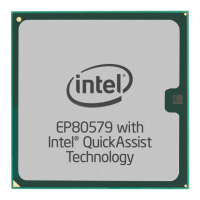Intel
®
EP80579 Integrated Processor Product Line—IEEE 1588-2008 Hardware Assist Interface
Intel
®
EP80579 Integrated Processor Product Line
Platform Design Guide May 2010
233 Order Number: 320068-005US
20.1.1 Input
Two input pins, AMMSSIG and ASMSSIG, connect to the IEEE 1588-2008 hardware
module. These signals can be used to detect status change of events that will require a
timestamp for tracking purpose. A typical example can be to adjust gain in a close loop
system using servo motors to control the mechanism of a fast moving robotic arm.
The hardware detects signal status changes by detecting positive edges. Once a
positive edge is detected, the hardware will timestamp the event and store the
timestamp information in either the Auxiliary Master or Auxiliary Slave register,
depending on what signal is being detected. The hardware will then generate an
interrupt to the processor that indicates a snapshot event has been captured and it
needs to be serviced. The processor can choose to ignore the event or service it. An
output can be generated to trigger additional external hardware as part of a close loop
system or simply for debug purposes.
20.1.2 Outputs
There is a total of four programmable output pins:
• 1588_TESTMODE_DATA
• 1588_PPS
• 1588_RX_SNAP
• 1588_TX_SNAP
These signals can be used to trigger external hardware or signal out the detections of
messaging timestamp of any of the two Ethernet or CAN network interfaces. The
maximum frequency of these signals is 66 MHz, which is derived from the APB bus
clock frequency.
1588_RX_SNAP and 1588_TX_SNAP are programmable signals that can be used to
generate triggering pulses when receiving or generating timestamps from GbE0/GbE1
and CAN0/CAN1.
TP_PPS pulse per second signal can be programmed to generate sequential pulses,
which can be used to generate a clock for the synchronization purposes of external
hardware. The duty cycle of the signal is 50% and is ideal for clocking external devices.
1588_TESTMODE_DATA will be used on future applications.
20.1.3 Board Design Tips
Implement standard board design rules for 66 MHz signal speed.
Signals that are not being used can be left floating. For the signals being used, board
impedance can be anywhere from 45 to 65 ohm.

